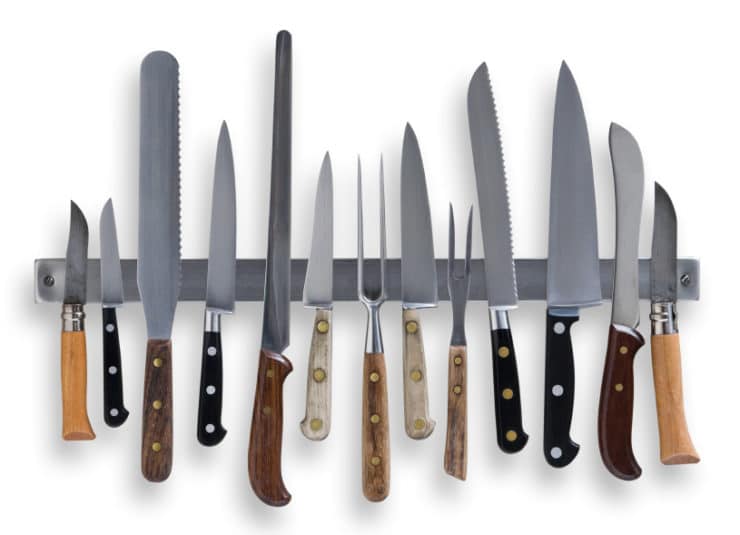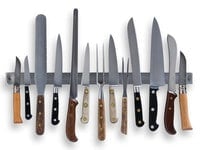
I’m storing my growing kitchen knife collection on a magnetic strip, like this one. It keeps my most useful kitchen tools within easy reach!
Hi there, fellow foodies! Yesterday I gave you some tips to keep in mind when investing in kitchen knives. Today, I’m going to give you a brief description of the major top-tier knife brands and their benefits. As I mentioned yesterday, different knives are suited to different purposes. This list should help you understand the various advantages of each major knife brand.
I’m not going to delve into brands like Calphalon, KitchenAid and Cuisinart here. There is nothing wrong with these brands; they can provide great starter sets for home cooks who aren’t ready to invest in higher quality knives. But for the purposes of this blog, I’ve limited the list to the top-tier knife companies. All of the brands discussed here are regularly used by professional chefs. They are companies that specialize in cutlery, who have built a strong reputation around the quality and durability of their products. And while there are many, many other small boutique knife brands out there, the ones on this list are the top sellers in their category.
Keep in mind that many of the upper tier brands, including Wusthof and Zwilling, also sell value brand sets that are lower quality (but easier on the wallet). Any knife block set that costs less than $250 is value branded… just because it bears the name of a well-known brand doesn’t mean you’re getting an heirloom-quality set of knives. Read reviews and do some research before investing in your kitchen tools; if a bargain seems too good to be true, it probably is.
As I said yesterday, a knife is a very personal thing. These brand descriptions will give you some rough guidelines, but it’s very important for you to test drive any knife before purchasing. While a sturdy Wusthof may be perfect for some cooks, others prefer the weight and balance of a Global. The best way for you to find your perfect match is to try out a few knives and see how they feel in your hand.
And now, the brands!
Wusthof makes German knives, known for their strength and durability. The family owned company has been around since 1814. Wusthof knives are forged from one solid piece of heavy-duty steel, making them ideal for tough tasks like frenching lamb racks and breaking down whole chickens. They are probably the most popular brand of upper-tier knives, with good reason—their quality is undeniable. The Wusthof Classic and Classic Ikon knives are used by many well-known chefs, including Emeril Lagasse and Gordon Ramsay.
Zwilling knives are similar to Wusthofs in terms of weight and feel. J.A. Henckles is a German manufacturer that has been around for over 200 years. The Zwilling part of the company manufactures their higher end knife lines, including the TWIN, Four Star, and Professional “S” lines. All Zwilling knifes are jointlessly assembled, which means there aren’t any weak points in the steel of the knife (which means less breakage). They are also rust-resistant. Zwilling knives and Wusthof knives are quite comparable in terms of quality and durability, so if you’re considering a heavy German-style knife, test drive both brands before making a decision.
Shun is an American manufacturer that produces Japanese-style knives. Japanese-style knives are generally lighter and sharper than German knives, but they also lose their edge faster than other knives. Shuns are sharpened at a 16 degree angle, as opposed to a 22 degree angle like most German knives. This steeper angle leads to superior sharpness. While many Japanese knives tend to get dull quickly, Shun knives are made of a special steel called VG-10 that allows them to keep their sharp edge for a long time. The VG-10 is blended with another type of steel during production, which causes a pretty wave pattern on the blade.
For those of you who read yesterday’s blog, you’ll remember my new chef’s knife Mordechai… he happens to be a Shun (from the Bob Kramer line). 🙂
Those of you who’ve owned a Swiss Army knife know that quality and strength are synonymous with the Swiss Army name. Swiss’s kitchen cutlery line, produced under the name Victorinox/Forschner, lives up to the excellent reputation Swiss Army has so carefully created. Victorinox knives are stamped, rather than forged like most high-end knives. Because of this, they’re not as expensive as the other brands on this list. However, many cooks swear by their quality. They’ve repeatedly been singled out by Cooks Illustrated as a “best buy,” performing comparably to more expensive brands. If you’re looking for a quality knife that won’t break the bank, you’d do well to consider Victorinox/Forschner.
A quick side note: Victorinox happens to be the sole supplier of multi-purpose knives to the actual Swiss army.
Known for their single-piece stainless steel design, Globals have a thinner blade than most German knives; they were extremely popular with professional chefs in the 1990’s. They are lightweight and have an easy grip handle. They are also made of a harder alloy of steel than other brands, which allows them to keep a very sharp edge for a long time. However, because of the harder steel, Globals are more difficult to sharpen; you can really mess up a Global knife by sharpening it yourself, or taking it to the local knife sharpener. Take care when it comes time to sharpen a Global, or you could end up ruining your knife.
Messermeister, headquartered in in Solingen, Germany, produces both German and Japanese-style knives. They are drop-forged from high quality steelwith tapered bolsters. While not as widely known as other knife brands, the Messermeister name is associated with quality. I have a Messermeister potato peeler that is over 10 years old, and it still performs well (having never been sharpened). Messermeister’s German-style knives feel heavier and more substantial than Japanese-style knives. However, Messermeister also has a line called Mu Micarta that is produced in Japan. This line is lighter, made similar to other Japanese-style knives.
Mac Knives are a Japanese brand. Like Victorinox, they are stamped knives, not forged. Stamping produces a thinner, more flexible blade and “razor-like” sharpness—however, some cooks feel that stamped blades are sub-par to forged blades. I’ve come to believe that it’s really a matter of personal preference. A knife shouldn’t be crossed off of your list just because it’s stamped. Mac knives are known for being both light and strong. They are a favorite of chefs Thomas Keller (French Laundry) and Charlie Trotter.
This knife line is named after the late Al Mar, a well-known player in the high-end knife industry for many years. Al Mar knives are manufactured in Japan; they are quite beautiful in terms of fit and finish. The knives are known for their ultra-light Japanese design. The drawback of Al Mar is that they have fewer knife styles than larger cutlery companies like Wusthof and Zwilling.
Bob Kramer
Bob Kramer is a master bladesmith, one of only 14 in the world. I am currently on his waiting list for his signature chef’s knife, along with many, many other people. Some have been waiting years. Bob’s knives sell for over $2000 each. If I ever get to the top of the waiting list, I’ll invest in his knife without thinking twice. It’s the greatest of all kitchen knives. Watch the video on his site to learn more.
Hopefully this information has been helpful to those of you searching for kitchen knives. The bottom line is, take your time, try out a few knives, and pick the ones that best suit you. Don’t be afraid to invest in quality—with proper care, these knives will be your best friends in the kitchen for many years to come. If you have room in your budget, it’s a worthwhile splurge. After all, how can you be expected to cut that beautiful Passover brisket without your own perfect chef’s knife? 🙂



It’s wonderful! Articles, Amazing!
Really love to read this post and its seems like a great blog i have ever seen. Just read your article.
Good one. I liked it. Keep going. you are a best writer your site is very useful and informative thanks for sharing!
Tori, Just found this as I was looking at replacing my old, general purpose sabatiers with a set of Wüsthof Classics. You mention the ‘ultimate’ knives. Have you heard of Will Ferraby’s knives? There is a clip here where Michel Roux Jnr talks about them and helps to make one. https://www.youtube.com/watch?v=Yje8rCMKUnU&t=9s. It is sort of mesmerising! Ferraby’s web site is here where he has a peculiar method of stocking and selling them. http://www.ferrabyknives.co.uk. Enjoy. Great blog article, btw, and confirms I have made a good choice with my Wüsthofs (Ferraby too rich for my blood!).
thanks. great post. yesterday’s was also helpful. i’ve used henckels for several years and have found them to fit my hand well and comfortably. i like your logo, btw.
hope you don’t mind if i share this with my FB audience.
What should you do with a knife if a blade falls if you haven’t sharpened it properly
Carson, I’m not sure I understand your question. What do you mean if a blade falls?
Mac is a Japanese brand not American, just to clearify that 🙂
Hi Mike, thanks. Last I checked the knives are manufactured in America (as the post states), even though it’s a Japanese brand, but I will clarify the post so there is no confusion.
Most high end quality knives are going to be made well and are sure to be sharp and hold an edge, but with knives, size does matter.Whatever your selection may be, balance is critical. A knife should feel good in your hand, feel solid and be of a weight that is comfortable to you so that you don’t hurt yourself.
Agreed!